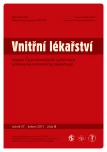-
Medical journals
- Career
Improvement of quality of life after ablation of longstanding persistent versus paroxysmal atrial fibrillation: results of 2-year follow-up
Authors: V. Bulková 1,2; M. Fiala 3; L. Haman 4; J. Chovančík 3; L. Škňouřil 3; Š. Havránek 1; J. Pindor 3; J. Duda 4; J. Gorzolka 3; Kateřina Ivanová 2; P. Pařízek 4
Authors‘ workplace: II. interní klinika kardiologie a angiologie 1. lékařské fakulty UK a VFN Praha, přednosta prof. MUDr. Aleš Linhart, DrSc. 1; Ústav sociálního lékařství a zdravotní politiky Lékařské fakulty UP Olomouc, přednostka doc. PhDr. Kateřina Ivanová, Ph. D. 2; Oddělení kardiologie Nemocnice Podlesí, a. s., Třinec, přednosta prim. MUDr. Marian Branny 3; I. interní klinika Lékařské fakulty UK a FN Hradec Králové, přednosta prof. MUDr. Jan Vojáček, DrSc. 4
Published in: Vnitř Lék 2011; 57(5): 456-462
Category: Original Contributions
Overview
Aims:
The purpose of the study was to assess quality of life and socio-economic parameters in patients after ablation of paroxysmal versus longstanding persistent atrial fibrillation (AF).Methods:
The study included 89 patients with paroxysmal AF and 56 patients with longstanding persistent AF who underwent ablation within 1 year, and were afterwards prospectively followed up for 2 years. Quality of life was evaluated by the EQ-5D questionnaire before and every 6 months after ablation.Results:
Objective, respectively subjective quality of life at baseline was lower in patients with longstanding persistent AF (67 ± 16 vs 71 ± 10; p = 0.01, resp. 64 ± 12 vs 67 ± 16; p = 0.07); however, after 2 years, it exceeded that of the patients with paroxysmal AF (80 ± 17 vs 75 ± 18; p = 0.03; resp. 73 ± 13 vs 70 ± 17; p = 0.18). The baseline-2 year difference in improvement was higher in patients with longstanding persistent AF in both objective (p = 0,001) and subjective component (p = 0.05). Both groups displayed significant decrease in the days of hospitalization, and the days of working incapacity.Conclusion:
Patients with longstanding persistent AF exhibit worse baseline quality of life than the patients with paroxysmal AF, and higher quality of life improvement after ablation.Key words:
atrial fibrillation – paroxysmal atrial fibrillation – persistent atrial fibrillation – quality of life
Sources
1. Wokhlu A, Monahan KH, Hodge DO et al. Long-term quality of life after ablation of atrial fibrillation: the impact of recurrence, symptom relief, and placebo effect. J Am Coll Cardiol 2010; 55 : 2309–2316.
2. Chan PS, Vijan S, Morady F et al. Cost-effectiveness of radiofrequency catheter ablation for atrial fibrillation. J Am Coll Cardiol 2006; 47 : 2513–2520.
3. Wazni OM, Marrouche NF, Martin DO et al. Radiofrequency ablation vs. Antiarrhythmic drugs as first-line treatment of symptomatic atrial fibrillation: a randomized trial. JAMA 2005; 293 : 2634–2640.
4. Jaïs P, Cauchemez B, Macle L et al. Catheter ablation versus antiarrhythmic drugs for atrial fibrillation: the A4 study. Circulation 2008; 118 : 2498–2505.
5. Wilber DJ, Pappone C, Neuzil P et al. Comparison of antiarrhythmic drug therapy and radiofrequency catheter ablation in patients with paroxysmal atrial fibrillation: A randomized controlled trial. JAMA 2010; 303 : 333–340.
6. Packer DL, Bardy GH, Worley SJ et al. Tachycardia-induced cardiomaopathy: a reversible form of left ventricular dysfunction. Am J Cardiol 1986; 57 : 563–570.
7. Lévy S, Maarek M, Coumel P et al. Characterization of different subsets of atrial fibrillation in general practice in France: the ALFA study. The College of French Cardiologists. Circulation 1999; 99 : 3028–3035.
8. Diamond GA, Forrester JS. Analysis of probability as an aid in the clinical diagnosis of coronary-artery disease. N Eng J Med 1979; 300 : 1350–1358.
Labels
Diabetology Endocrinology Internal medicine
Article was published inInternal Medicine

2011 Issue 5-
All articles in this issue
- Treatment of critical limb ischemia and diabetic foot disease by the use of autologous stem cells
- Improvement of quality of life after ablation of longstanding persistent versus paroxysmal atrial fibrillation: results of 2-year follow-up
- Blood lipid changes at long-term antiretroviral treatment
- Cardiotoxicity of cancer therapy
- Sorafenib in the treatment of hepatocellular carcinoma
- Infectious complications in patients after cardiac arrest undergoing therapeutic hypothermia
- The decrease in morbidity and mortality of patients with chronic forms of ischemic heart disease is the result of conservative treatment
- Internal medicine and cognitive decline in seniors
- Sulodexid and nephrotic syndrome in patients with diabetic nephropathy
- Morbus Ormond (idiopatic retroperitoneal fibrosis)
- Disturbance of synthesis of cholesterol and its precursors in clinically serious conditions
- Internal Medicine
- Journal archive
- Current issue
- Online only
- About the journal
Most read in this issue- Morbus Ormond (idiopatic retroperitoneal fibrosis)
- Cardiotoxicity of cancer therapy
- Internal medicine and cognitive decline in seniors
- Disturbance of synthesis of cholesterol and its precursors in clinically serious conditions
Login#ADS_BOTTOM_SCRIPTS#Forgotten passwordEnter the email address that you registered with. We will send you instructions on how to set a new password.
- Career

